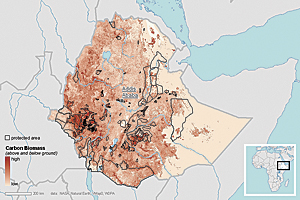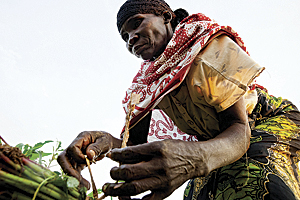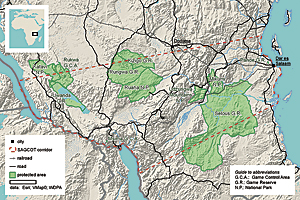Sustainability in Africa
By Peter A. Seligmann and Sandy J. Andelman, Conservation International
"We need to take stock and attach value to our natural resources and ecosystems, such that we may include their value in planning and decision-making processes, as well as in our national accounts and balance sheets."
Although His Excellency President Ian Khama of Botswana was speaking about Africa in his opening remarks to the first Summit for Sustainability in Africa, his words apply equally to the rest of the globe.

This map was part of a series created for the first Summit for Sustainability in Africa, held in Gaborone in May 2012 to demonstrate the natural capital of participating countries. In this example, the ecosystem service of climate regulation through carbon storage is shown, along with the country's protected area network.
The goal of the summit, hosted in Gaborone last May by the government of Botswana and Conservation International, was to demonstrate how African nations and their investment partners understand, manage, and value natural capital to support and improve human well-being. The aim was to take a practical, results-focused approach, with African nations leading and encouraging investment partners to provide support in a coordinated and coherent fashion.
The term natural capital refers to earth's natural assets (soil, air, water, plants, and animals) and the ecosystem services resulting from them (e.g., food production, climate regulation, pollination, flood protection) that sustain human life.
The visionary heads of state and ministers of 10 African nations—Botswana, Gabon, Ghana, Kenya, Liberia, Mozambique, Namibia, Rwanda, South Africa, and Tanzania—unanimously voiced their support for the value of natural capital in national accounting. These nations reached two key conclusions. First, there was unanimous consensus that the historical pattern of resource exploitation has failed to promote sustained growth, environmental integrity, and improved social capital and has, even worse, been counterproductive. Second, they agreed that the value of natural capital—the wealth of benefits provided to people by biodiversity and ecosystems, like watersheds, forests, coral reefs, and grasslands—must be fully accounted for and integrated into national and corporate planning, as well as reporting practices, policies, and programs.
The message resulting from the summit—the Gaborone Declaration—reaffirmed a commitment to sustainability already shared by these visionary leaders. The declaration signaled a new era of leadership, rooted in Africa, that understands, values, and manages the natural capital that sustains all of us: a platform on which we can begin to build a sustainable future.
Summit participants included Sam Dryden, director of agricultural development at the Bill & Melinda Gates Foundation; Laurene Powell Jobs, chair and founder of Emerson Collective; Rachel Kyte, vice president of sustainable development at the World Bank; Rob Walton, the chairman of Walmart; and numerous other private- and public-sector partners from within and outside Africa. These participants also issued a communiqu� to draw attention to what they described as "the limitations of GDP [gross domestic product] as a measure of well-being and sustainable growth that values environmental and social aspects of progress."
In closing the summit, President Khama emphasized the importance of following through on these commitments. "This meeting will not be of any value to our peoples if we fail to achieve the objectives that formed the core of this summit, that is, integrating the value of natural capital into national and corporate accounting and planning," he said. "We must continue building social capital and reducing poverty by transitioning agriculture and extractive industries to practices that promote sustainable employment and the protection of natural capital while building the knowledge, capacity, and policy networks needed to promote leadership and increase momentum for change."
This is true leadership and an example we should celebrate and follow.
The Gaborone Declaration marked an important step in paving the way toward mutually beneficial partnerships between governments and businesses. A month later, at Rio+20—the United Nations Conference on Sustainable Development—these 10 African nations united under the Gaborone Declaration and emerged as global leaders. They urged others to join them in taking the first steps to correct what has been, up until now, a misguided development trajectory. They were followed by 49 other nations, developed and developing alike, along with nearly 100 public, private, and civil society partners, including ArcelorMittal, the Coca-Cola Company, the Bill & Melinda Gates Foundation, the German Development Institute, the MacArthur Foundation, the United Nations Environment Programme, the United Nations Permanent Forum on Indigenous Issues, Walmart, Woolworths, the World Bank, and World Vision.
Measuring Sustainability: Getting the Metrics and Measurements Right
The recent Stiglitz-Sen-Fitoussi Commission on the Measurement of Economic Performance and Social Progress (2009) put it very clearly:

The harvesting of amaranth greens. (Photo courtesy of Conservation International. Copyright � Benjamin Drummond.)
What we measure affects what we do; and if our measurements are flawed, decisions may be distorted. . . . Those attempting to guide the economy and our societies are like pilots trying to steer a course without a reliable compass. The decisions they make depend on what we measure, how good our measurements are and how well our measures are understood. We are almost blind when the metrics on which action is based are ill-designed or when they are not well understood. . . . We need better metrics.
Ecosystem goods and services from natural capital provide an enormous contribution to the global economy, but natural capital has not been factored into conventional indicators of economic progress and human well-being like GDP or the human development index (HDI). Neither GDP per capita nor the HDI reflect the state of the natural environment. Both indicators focus only on the short term, giving no indication of whether current well-being can be sustained for future generations.
Many economists and politicians have become convinced that the failure of societies to account for the value of natural capital—as well as the use of indicators of well-being that don't reflect the state of natural capital—have contributed to degradation of the natural environment. We are using a flawed measurement approach to guide policy and decision making, and one key step toward achieving healthy, sustainable economies is to begin accounting for our use of natural capital. We must recognize and report the true cost of economic growth and our ability to sustain human well-being, both today and in the future. By incorporating the value of natural capital and ecosystem services, such as water provision, climate regulation, soil fertilization, or plant pollination, into our balance sheets, governments and businesses will be able to see a more holistic and accurate picture of natural and national wealth.
Sustainability and Food Security: Grow Africa and the G8 New Alliance for Food Security and Nutrition
Ann's story that follows is representative of hundreds of millions of farmers across sub-Saharan Africa. The continent's smallholder agricultural systems have inadvertently degraded vital ecosystem services like flood protection, water supply, and soil nutrient cycling:
Ann is 75 years old, a feisty grandmother in Wasare, Kenya, near Lake Victoria. She remembers five decades ago as a fish trader, when the water was clear, fish were abundant, the hilltops were green and lush, and harvests were plentiful. Now, she barely ekes out a living on her family farm. Like all her neighbors', Ann's field is planted with corn, but the soil underneath the rows of corn is gravely wounded and pale, drained of vital minerals. Gulleys scar the landscape, evidence of sustained hemorrhaging of fertile soils.
According to Jon Foley of the University of Minnesota, feeding the growing world population in the next 40 years will require producing as much food as we have produced in the last 8,000 years. This equates to a 70-100 percent increase in food production through agricultural intensification and expansion, mainly in developing countries. In this context, Africa is central to solving the world's food security and sustainability challenges. Africa contains 12 percent of the globe's land that is suitable for agriculture, but only 33 percent of this land currently is cultivated. Africa also offers significant opportunities to increase production on existing agricultural lands by filling yield gaps (i.e., the difference between current crop yields in a given location and the potential yield for the same location) using improved agricultural management and new technologies.
Two other processes that focus on food security and involve many of the same governments and private-sector players are the World Economic Forum's Grow Africa Initiative and the G8 New Alliance for Food Security and Nutrition. These initiatives have been moving forward, largely independently of and parallel to the Summit for Sustainability in Africa and Rio+20, yet they underscore the importance and timeliness of the Gaborone Declaration.
Building on public-private partnership models piloted by the World Economic Forum's New Vision for Agriculture Initiative, Grow Africa is a public-private partnership platform. It aims to accelerate investments and transform African agriculture in accordance with national agricultural priorities and in support of the Comprehensive Africa Agriculture Development Programme, a program of the New Partnership for Africa's Development established by the African Union in 2003. At the Grow Africa Investment Forum last May, held at the glamorous African Union Conference Centre in Addis Ababa, seven African governments presented opportunities for multinational, private-sector investment.

Map showing the Southern Agricultural Growth Corridor of Tanzania (SAGCOT), where the government is attempting to transform agricultural development, increase food production, and reduce poverty through a targeted program of public-private partnerships. The corridor is critically important for maintaining natural capital and contains important protected areas that also provide revenue from ecotourism.
Also in May, at Camp David (the US president's retreat in Frederick County, Maryland), the G8 countries announced the New Alliance for Food Security and Nutrition. The New Alliance, also a public-private partnership, is being promoted as a mechanism to raise 50 million people in Africa out of poverty over the next 10 years. The G8 committed $1 billion, together with $3 billion in pledges from 45 agribusiness companies, and is initially targeting Ethiopia, Ghana, and Tanzania. While applauding the focus on lifting 50 million people out of poverty, several African civil society groups and international organizations, such as the agency Oxfam, have criticized the alliance's top-down approach and its failure to bring smallholder farmers—particularly women—to the table. They have also voiced concern about its lack of attention to environmental sustainability.
We are clearly gaining traction and attention on these critical challenges, but we need to integrate our efforts to strengthen our collective impact.
Looking Ahead to Increased Sustainability
As stated by Kenyan Alex Awiti, director of the East African Institute at Aga Khan University in Nairobi, "A fundamental question underlies Africa's socioeconomic and environmental sustainability: How can smallholder farmers increase land productivity, profitability, and human well-being outcomes without causing irreparable damage to the natural world on which they depend?"
Africa's smallholder production systems, like global agricultural production systems, depend on essential natural capital—the ecosystem services produced by ecosystems at many spatial scales, such as rainfall and water captured by forests or from underground aquifers or vegetation from grasslands and savannas to feed cattle, goats, and sheep. As a result, solutions to the challenges faced by smallholder farmers require a landscape-level approach.
However, much of the existing knowledge of ecosystems and agricultural systems in Africa is local, fragmented, often inaccessible, and seldom mapped at the scales relevant for decision making. As a result, policy makers, farmers, and investors often make important land-use and land management decisions based on partial and incomplete understanding of landscape-level interactions and feedback.
Without concerted investments in a framework with the right metrics, indicators, and data to track changes in ecosystem services and human well-being, gains in food production are unlikely to be sustainable in the long run. At worst, they may unintentionally degrade the environment.
Conservation International and partners have argued, therefore, for a new, holistic, evidence-based approach to supporting African agriculture, one that improves decisions on sustainable land use and land management and provides a holistic understanding of ecosystem health and human well-being.
Africa needs an integrated diagnostic and monitoring framework to generate data and information at appropriate scales to support decision making at household, national policy, and international and global investment levels: an instruction manual, if you will, to ensure that communities, investors, growers, and decision makers are operating in sync. Such a framework requires a strategically selected set of indicators that integrate information about land productivity, soil and plant health, biodiversity, water availability, and human well-being in a scientifically credible way. At the same time, the set of indicators must be small enough that decision makers aren't overwhelmed with too much information.
Farmers like Ann, African governments, and investors like the G8 and multinational corporations need a system of metrics and indicators that provide information at the right scales. These indicators are the missing piece that will help minimize environmental impacts of food production, as well as ensure that the well-being of Ann and millions of farmers like her across sub-Saharan Africa can be improved in a sustainable manner.
Over the last two years, with funding from the Bill & Melinda Gates Foundation, Conservation International has worked together with a broad set of science and policy partners to identify the right set of metrics for measuring natural capital. These metrics are intended to map the flow of ecosystem goods and services to people and to quantify the contributions of these services to human well-being. We tested this framework in southern Tanzania, including the Southern Agricultural Growth Corridor of Tanzania (SAGCOT), where the country's government is attempting to transform agricultural development, increase food production, and reduce poverty through a targeted program of public-private partnerships. The corridor [see ArcGIS map on page 16] is critically important for maintaining natural capital and contains important protected areas that also provide revenue from ecotourism. As with Grow Africa, some questions and concerns are being raised with respect to SAGCOT: whether it is commercially viable, whether large commercial farms will dominate the landscape at the expense of the region's poorest farmers, whether investments will be transparent, whether fears of land grabbing will be addressed, and whether there will be transparent processes for investments and auditing. Without access to integrated information on the socio-agroecosystems within the corridor—information that can gauge the success of the agricultural investments and the environmental and socioeconomic outcomes—there is significant risk that SAGCOT will fall short of its transformational goals.
Vital Signs Africa
Having identified the metrics and demonstrated the feasibility of making the necessary measurements at the right scales, we're ready to think bigger, act bigger, and dramatically scale up. Recently, Conservation International, in collaboration with Columbia University, the Council for Scientific and Industrial Research in South Africa, and the Earth Institute, launched Vital Signs Africa, an integrated monitoring system for agriculture, ecosystem services, and human well-being. The first phase of Vital Signs, funded by the Bill & Melinda Gates Foundation, focuses on regions in five countries in sub-Saharan Africa, including Ethiopia, Ghana, and Tanzania. These regions were selected because they are where agricultural transformation is targeted to meet the needs of Africa's growing population. Measurements will be collected through a combination of ground-based data collection, household surveys, and high-resolution and moderate-resolution remote sensing.
Currently, no African countries have environmental monitoring systems, and Vital Signs aims to fill that gap. The system emphasizes capacity building, working through subgrants to local scientists who will collect information and partnerships with existing data collection efforts, such as the Tanzania National Bureau of Statistics. It focuses on building local capacity for analysis and synthesis of spatial information, as well as on the capacity of African policy makers and institutions to understand and use this kind of information.
Data collection will happen at multiple scales to create the most accurate possible picture: a household scale, using surveys on health, nutritional status, and household income and assets; a plot scale to assess agricultural production and determine what seeds go into the land, where they come from, what kind of fertilizer is used, what yield of crops they deliver, and what happens after the harvest; a landscape scale (100 km2) measuring water availability for household and agricultural use, ecosystem biodiversity, soil health, carbon stocks, etc.; and a regional scale (~200,000 km2) that will tie everything together into a big picture to enable decision makers to interact with the information at the scales on which agricultural development decisions are made. High-resolution (e.g., QuickBird, WorldView-2) and moderate-resolution (e.g., Landsat, SPOT) remote sensing will provide wall-to-wall coverage.
Vital Signs aims to fill the crucial information gap, providing a set of metrics to quantify the value of natural capital for agriculture and for human well-being; using the right measurements at the right scales; and offering a set of indicators and tools to provide policy makers, farmers, and investors with the holistic understanding they need for better decision making.
These are long-term endeavors that will take time to realize but offer a smarter way forward as we work to build healthy, sustainable economies that support people and our planet.
About the Authors
Peter A. Seligmann is chairman and chief executive officer of Conservation International and has been a leader in creating conservation solutions for the past 36 years. Since he founded the organization in 1987, Conservation International has earned a reputation as an organization on the cutting edge, creating innovative and lasting solutions to the threats facing humanity, biodiversity, and the natural systems that sustain us all. Dr. Sandy J. Andelman is the executive director of the Vital Signs Monitoring System and is a vice president at Conservation International. Vital Signs fills a critical unmet need for integrative, diagnostic data on agriculture, natural capital, and human well-being. Andelman has pioneered the creation of global monitoring and forecasting systems for climate change and ecological change.
For more information, contact Sandy Andelman, Conservation International (e-mail: s.andelman@conservation.org), and visit conservation.org or vitalsigns.org.